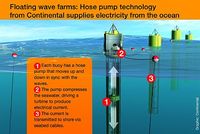Continental's AquaBuOY Converts Waves Into Energy
HANOVER – November 3, 2008 : Almost three-quarters of the earth’s surface consist of water which is almost always on the move. Whether motion is generated by currents, tides, or storms: there is an endless amount of energy available within the world’s oceans. So waves could be the energy resource of the future. What’s more, marine energy is produced without any CO2 emissions, so it is environmentally friendly as well.
As a specialist in rubber and plastics technology, ContiTech, a subsidiary of Continental AG, has now developed “AquaBuOY”, a wave energy converter, together with its Canadian partner Finavera Renewables. “We have concentrated on a technology that works with a hose pump and a buoy that moves up and down”, says Dr. Ali Reza Kambiez Zandiyeh, who is responsible for the project at ContiTech Fluid Technology in Grimsby, UK. The hose pump of the “AquaBuOY” moves up and down in sync with the waves. In doing so, the pump compresses the seawater, driving a turbine to produce electric current. The current is then transmitted to shore via seabed cables.
The biggest challenge: a wave power station needs to withstand the heaviest storms on the one hand and still produce energy when waves are low on the other hand. The first “AquaBuOY” tests off the coast of Newport, Oregon, were successful. The hose pump system fulfilled the extreme requirements, generated hydraulic power, and delivered continuous high performance.
“Our development is a major step in the direction of economical generation of electricity from marine energy,” says Jason Bak, CEO of Finavera Renewables. Jochen Bard, a graduate physicist and expert in the field of marine energy at the Institute for Solar Energy Technology (ISET) in Kassel, also believes in the new means of energy recovery from the ocean: “Approximately one third of the globe’s electricity requirements could be generated from marine energy. Wave power has such a huge potential that we simply must tap that energy resource in the future. All countries situated on the west coast of Europe are excellent wave farm sites. The UK alone could draw 10% to 20% of its energy needs from the ocean.”
Floating wave farms supply electric power from the ocean. “Depending on the local situation, our wave power station will consist of between 30 and 50 buoys,” estimates Zandiyeh. Bard, too, is confident: “Investment in this renewable energy is a high priority worldwide. Those who are already geared up for this technology will quickly secure leadership for themselves.”



